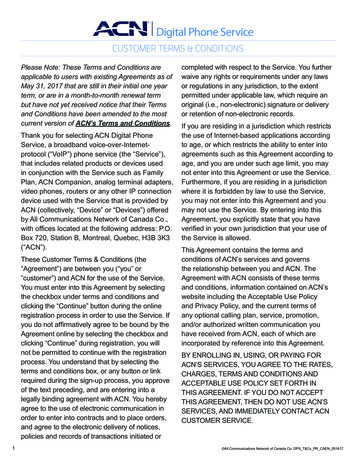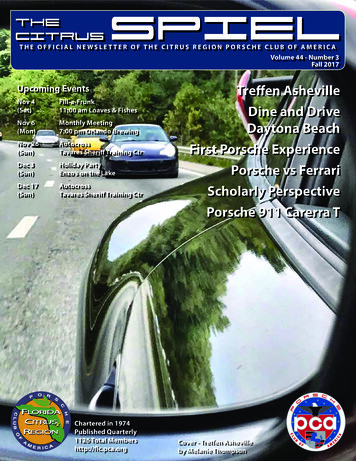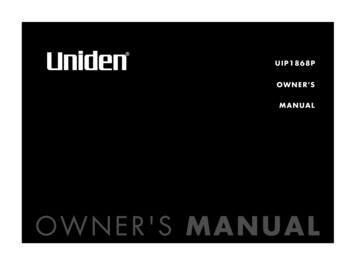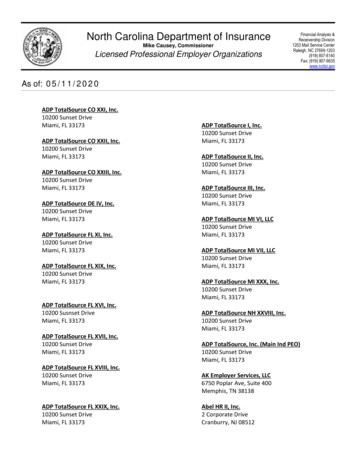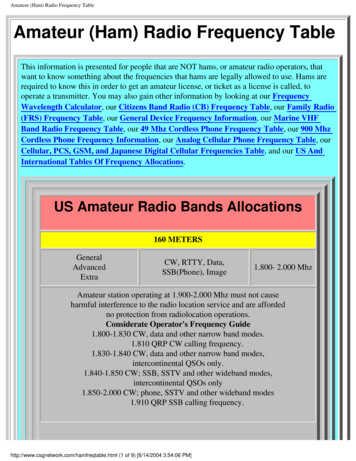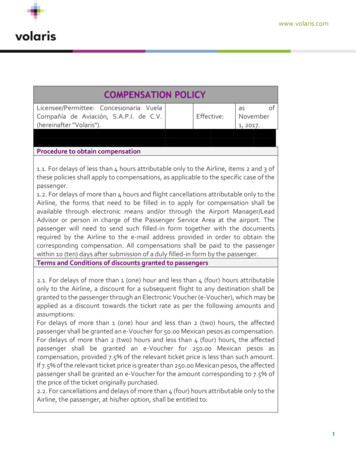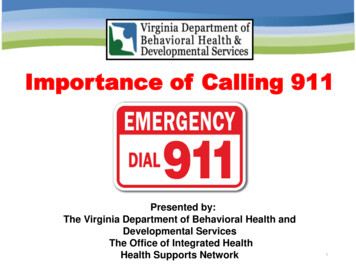
Transcription
Importance of Calling 911Presented by:The Virginia Department of Behavioral Health andDevelopmental ServicesThe Office of Integrated HealthHealth Supports Network1
PurposeThis training is brought to you by the Office ofIntegrated Health (OIH), Health Supports Network(HSN) Registered Nurse Care Consultants (RNCC)This training is for community service providers andreinforces the importance of calling 911 as quickly aspossible to eliminate preventable deaths that may beattributed to caregiver delays.
How to use this training Welcome each participant.Turn off phones and reduce distractions.Review the purpose for the Training.Review the learning objectives.Hand out a piece of paper to each of the trainingparticipants and have them complete the 5 question pretest.Put the answers away until the end.Review and discuss the content on each slide.Have participants take out their pre-test answers.Review the answers and ensure each participantunderstands the correct answer.3
Key Terms & Abbreviations OIH: Office of Integrated Health ID/DD: Intellectual Disability/Developmental Disability RNCC: Registered Nurse Care Consultant DBHDS: Virginia Department of Behavioral Healthand Developmental Services EMS: Emergency Medical System MRC: Mortality Review Committee NHTSA: National Highway Traffic Safety Administration REACH: Regional Educational Assessment CrisisResponse and Habilitation4
Learning ObjectivesAt the conclusion of this training,participants will be able to Define the term “EMS”. Describe what happens when you call 911. List four medical emergencies, thatshould always prompt a call to 911. State the value in calling 911.5
Pre - Test1) True / FalseEMS is a system that provides emergency medical care?2) Which statement reflects something that does nothappen when you call 911?A. Your 911 call is directed to the nearest emergencydepartment.B. The 911 operator will ask questions.C. The 911 operator will dispatch the right responders.D. The 911 operator may provide first aid or CPR instructions.E. The 911 operator may tell you to stay on the phone.6
Pre – Test, continued3) True / FalseDBHDS MRC has identified a numberof potentially preventable deathsthat may have been related to adelay in calling 9114) List four medical emergencies that (when observed),should always prompt you to call 911:a) b)c) d)5) True / FalseQuick recognition and treatment ofconditions like heart attacks and strokesimproves outcomes and can save lives.7
Why is this trainingimportant?According to the American HeartAssociation, only 46% of the250,000 people who experienceout-of-hospital cardiac arrest inthe U.S. each year get immediatehelp before a professional arrives.8
Facts about the causesof deathAccording to the American Heart Association and the CDC:Heart Disease is the #1 cause of deathboth globally and in the United States.After 3 decades of decline heartdisease deaths increased in the US by3% between 2011 and 2014.Every year in the US more than 500,000adults and children experience a cardiacarrest, and less than 15% survive.9
Facts about the causesof death in VirginiaIn 2018, the top known causes of death inVirginia’s DD Waiver population were:1. Unknown/Other2. Aspiration3. Cancer4. Sudden Cardiac Death5. Pneumonia6. Cardiovascular/Heart DiseaseSource: DBHDS Mortality Review Report, SFY 2018.10
What is EMS?“Emergency Medical Services, morecommonly known as EMS, is a systemthat provides emergency medicalcare. Once it is activated by anincident that causes serious illness orinjury, the focus of EMS is emergencymedical care of the patient(s)”Source:https://www.ems.gov11
What is a Serious Injury?Examples of Serious Injuries:(This is not a complete list only examples) An individual is unresponsive or displays any lack ofresponsiveness. An individual who is having trouble breathing. An individual who is having chest pain. An individual has severe bleeding not stopped by gentlepressure. An individual (who typically can move), has the inability tomove. An individual who is choking. An individual (who can typically ambulate), can’t bear weight. An individual who has excessive swelling to any area of theindividual’s body or any limb (legs, arms, etc.), after a fall.(Mayo Clinic, 2019a,b)12
What is 911?“911 is the universal number to call foremergency help nationwide, is a proven, lifesaving service to the public.”“National Highway Traffic Safety Administration(NHTSA) Office of EMS oversees the National 911Program, which envisions an emergencyresponse system that best serves the public,providing immediate help in all emergencysituations.”Source: https://www.ems.gov13
What is the value ofcalling 911?Calling 911 Saves LivesBecause “delays in recognition and treatment oftime-sensitive conditions like heart attacks,strokes and cardiac arrest can be the differencebetween life and death.”Michael Kurz, MD, chair of the American Heart Association’s Systems of CareSubcommittee and Associate Professor at the University of Alabama School ofMedicine in the Department of Emergency Medicine.14
What happens when youcall 911? Your call gets directed to a 911 call center The operator will ask a series of questions toquickly obtain information. These questions may include: The location of the emergency? The phone number you are calling from? The nature of the emergency?15
Calling 911, continued.You may be asked for details about the emergency.Such as: Description of injuries. Description of symptoms being experienced by a person.having a medical emergency. Physical description of a person if a crime was committed. Description of any fire that may be burning.You should provide the operator information as able.Such as: The individual’s primary diagnoses (such as: ID, Seizures). The individual’s essential supports (such as: wheelchair,oxygen). Significant medical history (such as: pacemaker, vagal nervestimulator, tracheostomy, catheters).16
What happens NEXT? The 911 operator will dispatch the rightresponders to your location. The operator may provide instructions aboutwhat to do until help arrives. You should follow the operators instructions . Operators may give you step by stepinstructions for what to do until help arrives.For example instruct you to: Perform life saving measures for choking. Provide first aid. Perform CPR.17
When does the call end?Do Not hang upunless the 911operator hangs up!!18
A Family’s Story Video Link:https://mail.google.com/mail/u/0?ui 2&ik bd7aa4ba30&attid 0.1&permmsgid msg-f:1658192466775597384&th 1703154357636148&view fimg&sz s0-l75-ft&attbid ANGjdJ8O8XQZq0ifcXA8-6JQ25 w8tigQ4NnouvEng42IxhuG dyfMC2GHK3oj17gJqghmXoty1A&disp emb&realattid ii k6h1jcws019
After calling 911 After the emergency is over then:Inform team members who support the individual assoon as possible.After the incident, you should inform: The individual’s Primary Care Provider to ensure appropriatefollow –up. The individual’s Support Coordinator to ensure the individual’sIndividualized Support Plan (ISP) is updated. The individual’s Day Support, work program, etc. to ensurecontinuity of care. The individual’s family or legal guardian to ensure goodcommunication. Make sure a CHRIS report is completed along with all otherrequired documentation.20
The Chain of SurvivalThe first step in the Chain of Survival isan immediate Call to 911.Do not delay this call for any reason.21
Let’s Review Calling 911 is a proven, life-saving service.Calling 911 can mean the difference betweenlife and death when treating time-sensitiveconditions like heart attacks, strokes andcardiac arrest!!Calling 911 can decrease the number ofpotentially preventable deaths related to adelay in calling 911, as identified by the DBHDSMortality Review Committee.22
Pre – Test Answers1)2)3)4)TrueATrueFour examples: An individual who is having trouble breathing.An individual who is choking.An individual who is unresponsive.An individual who is bleeding severely.(Other answers may be accepted by the training leader)5) True23
Behavioral CrisisWhen should you consider calling REACH?REACH is a crisis prevention, intervention andstabilization system to support individuals withintellectual and/or developmental disabilities,as well as a mental health condition orchallenging behavior that is negativelyaffecting their quality of life.REACH should be called early at the on-set ofthe crisis to alleviate the need to call 911.24
How to contact REACHREACH is NOT 911 but is available to provide crisisconsultation as well as on-site response as needed forindividuals experiencing a crisis not requiring 911.Region1 Hotline: (855) 917 - 8278Region 2 Hotline: (855) 897- 8278Region 3 Hotline: (855) 887- 8278Region 4 Hotline: (855) 282 -1006Region 5 Hotline: (888)255 -298925
Behavior CrisisDo Call 911 if the situationwarrants and if the person’sbehavior is life threatening tothemselves or others.26
American Heart Association (2014, December 17). American Heart Association statistical report tracks globalfigures for first time. Retrieved from igures-for-first-timeAmerican Heart Association (2017, August 4). CDC: U.S. deaths from heart disease, cancer on the rise.Retrieved from aths-from-heartdisease-cancer-on-theriseAmerican Heart Association (2019, June 18). Health data collaboration will improve outcomes formedical emergencies. Retrieved from sAmerican Red Cross (2016), Traumatic injuries (pp. 110-111). First Aid/CPR/AED Instructors Manual.USA: Staywell.Centers for Disease Control and Prevention, National Center for Injury Prevention and Control.(2019d). Web–based injury statistics query and reporting system (WISQARS).Mayo Clinic (2019a). Cuts and scrapes: First aid. Retrieved from basics/art-20056711Mayo Clinic (2019b). Head trauma: First aid. Retrieved from trauma/basics/artOffice of Integrated Health, Virginia Department of Behavioral Health and Developmental Services(n.d.). Documenting changes in a person’s status. Retrieved 20medical%20condition.pdfThe American Red Cross (2019). First aid steps, performing first aid. Retrieved d/performing-first-aid/first-aid-stepsVirginia Department of Behavioral Health and Developmental Services (2019, December). MRC report27to the DBHDS Quality Improvement Council.
DBHDS ResourcesOIH Health and Safety grated-health/safety-alerts-archive First Aid for Falls (September, 2019) Fall Prevention (September 2019) Choking (2018) 911 Assistance (2014) The Importance of Calling 911 (Coming inFebruary 2020)OIH -integrated-health/safety-alerts-archive28
NewsletterNovember201929
Still Have Questions?Please contact:The Virginia Department ofBehavioral Health andDevelopmental Disability(DBHDS)Office of Integrated Health(OIH)30
31
American Red Cross (2016), Traumatic injuries (pp. 110-111). First Aid/CPR/AED Instructors Manual. USA: Staywell. Centers for Disease Control and Prevention, National Center for Injury Prevention



